Organizational Performance and Leadership Styles: A Research Report
VerifiedAdded on 2023/06/07
|17
|3915
|403
Report
AI Summary
This report presents a detailed analysis of the impact of leadership styles on organizational performance, using the Department of Telecommunications and Postal Services (DTPS) as a case study. The research employs thematic analysis of qualitative data derived from interviews and questionnaires to explore various leadership styles, including autocratic, bureaucratic, transactional, and transformational approaches. The findings highlight the prevalence of transformational leadership and its positive correlation with organizational performance, while also acknowledging the need for a balanced approach incorporating transactional elements. The report examines key themes such as leadership as a source of empowerment, the provision of adequate resources, and the level of delegation, drawing on participant responses and relevant literature. It further explores demographic data, including gender, years of service, and highest qualifications of the participants, providing a comprehensive overview of the organizational context. The study concludes with recommendations aimed at optimizing leadership practices to enhance organizational effectiveness at DTPS.

Table of contents
Content Page Number
List of tables.......................................................................................................................ii
List of figures.....................................................................................................................iii
List of acronyms................................................................................................................iv
CHAPTER FOUR: RESULTS, DISCUSSION AND INTERPRETATION OF FINDINGS1
4.1 Introduction..............................................................................................................1
4.2 Analysis of demographics........................................................................................1
4.2.1 Gender of participants.......................................................................................2
4.2.2 Years of service.................................................................................................2
4.2.3 Highest qualification..........................................................................................3
4.3 Discussion on interview results................................................................................4
4.3.1 Rating of leadership styles................................................................................4
4.3.2 Emphasis on transactional and transformational leadership............................5
4.4 Discussion on objective questions...........................................................................5
4.4.1 Thematic analysis of qualitative data................................................................5
4.4.2 Theme identification..........................................................................................6
4.5 Thematic analysis of the research questions..........................................................6
4.6 Conclusion.............................................................................................................12
Bibliography.....................................................................................................................14
i
Content Page Number
List of tables.......................................................................................................................ii
List of figures.....................................................................................................................iii
List of acronyms................................................................................................................iv
CHAPTER FOUR: RESULTS, DISCUSSION AND INTERPRETATION OF FINDINGS1
4.1 Introduction..............................................................................................................1
4.2 Analysis of demographics........................................................................................1
4.2.1 Gender of participants.......................................................................................2
4.2.2 Years of service.................................................................................................2
4.2.3 Highest qualification..........................................................................................3
4.3 Discussion on interview results................................................................................4
4.3.1 Rating of leadership styles................................................................................4
4.3.2 Emphasis on transactional and transformational leadership............................5
4.4 Discussion on objective questions...........................................................................5
4.4.1 Thematic analysis of qualitative data................................................................5
4.4.2 Theme identification..........................................................................................6
4.5 Thematic analysis of the research questions..........................................................6
4.6 Conclusion.............................................................................................................12
Bibliography.....................................................................................................................14
i
Paraphrase This Document
Need a fresh take? Get an instant paraphrase of this document with our AI Paraphraser

List of tables
ii
ii
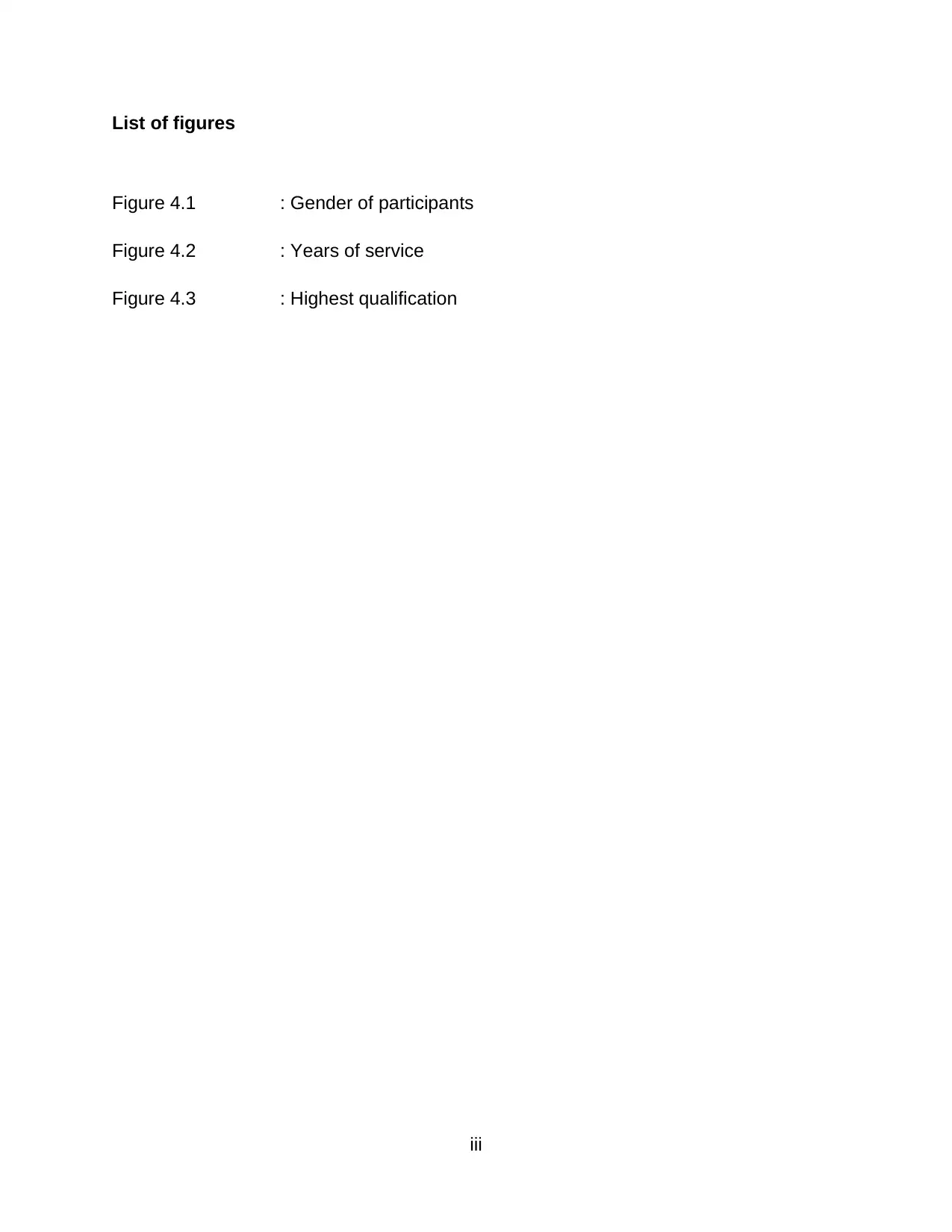
List of figures
Figure 4.1 : Gender of participants
Figure 4.2 : Years of service
Figure 4.3 : Highest qualification
iii
Figure 4.1 : Gender of participants
Figure 4.2 : Years of service
Figure 4.3 : Highest qualification
iii
⊘ This is a preview!⊘
Do you want full access?
Subscribe today to unlock all pages.

Trusted by 1+ million students worldwide
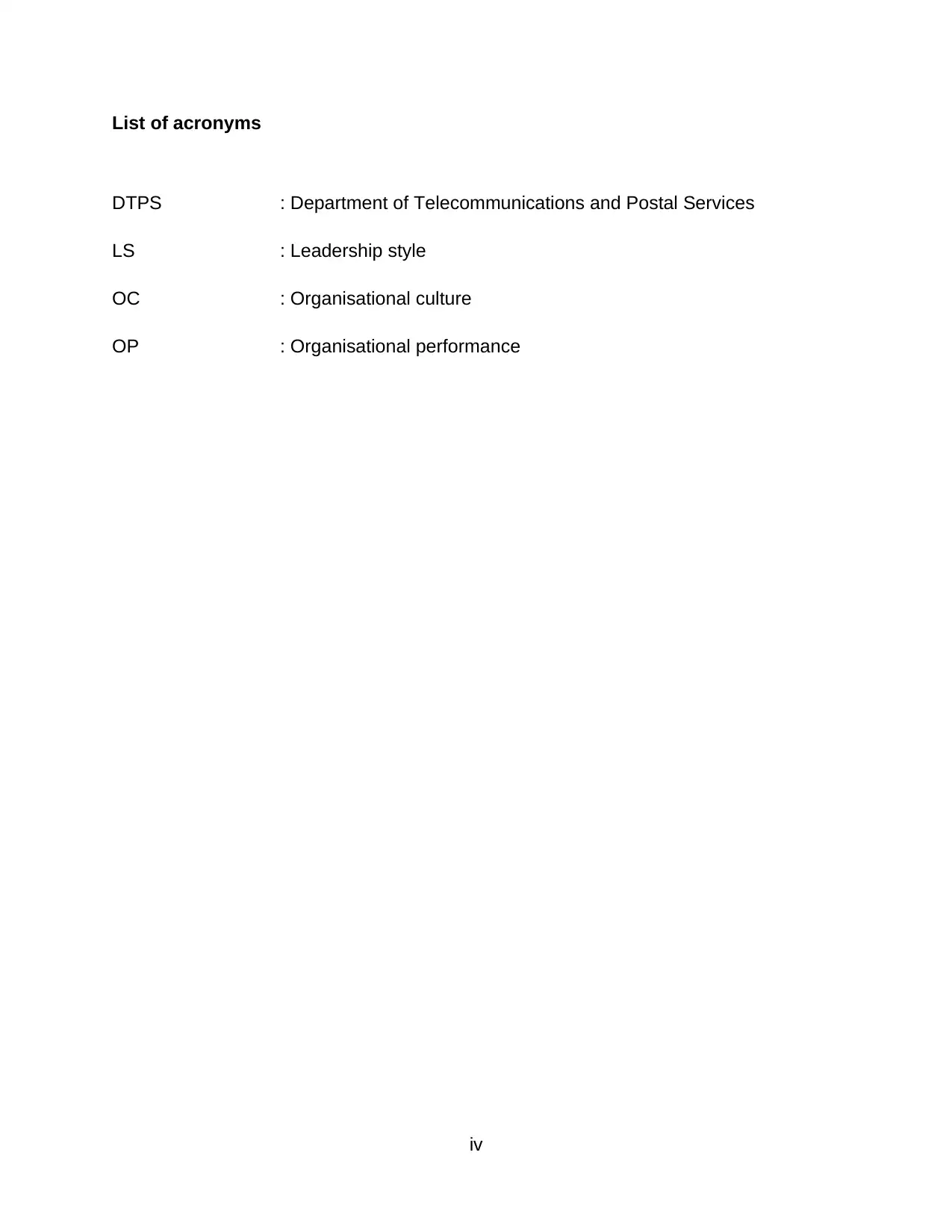
List of acronyms
DTPS : Department of Telecommunications and Postal Services
LS : Leadership style
OC : Organisational culture
OP : Organisational performance
iv
DTPS : Department of Telecommunications and Postal Services
LS : Leadership style
OC : Organisational culture
OP : Organisational performance
iv
Paraphrase This Document
Need a fresh take? Get an instant paraphrase of this document with our AI Paraphraser
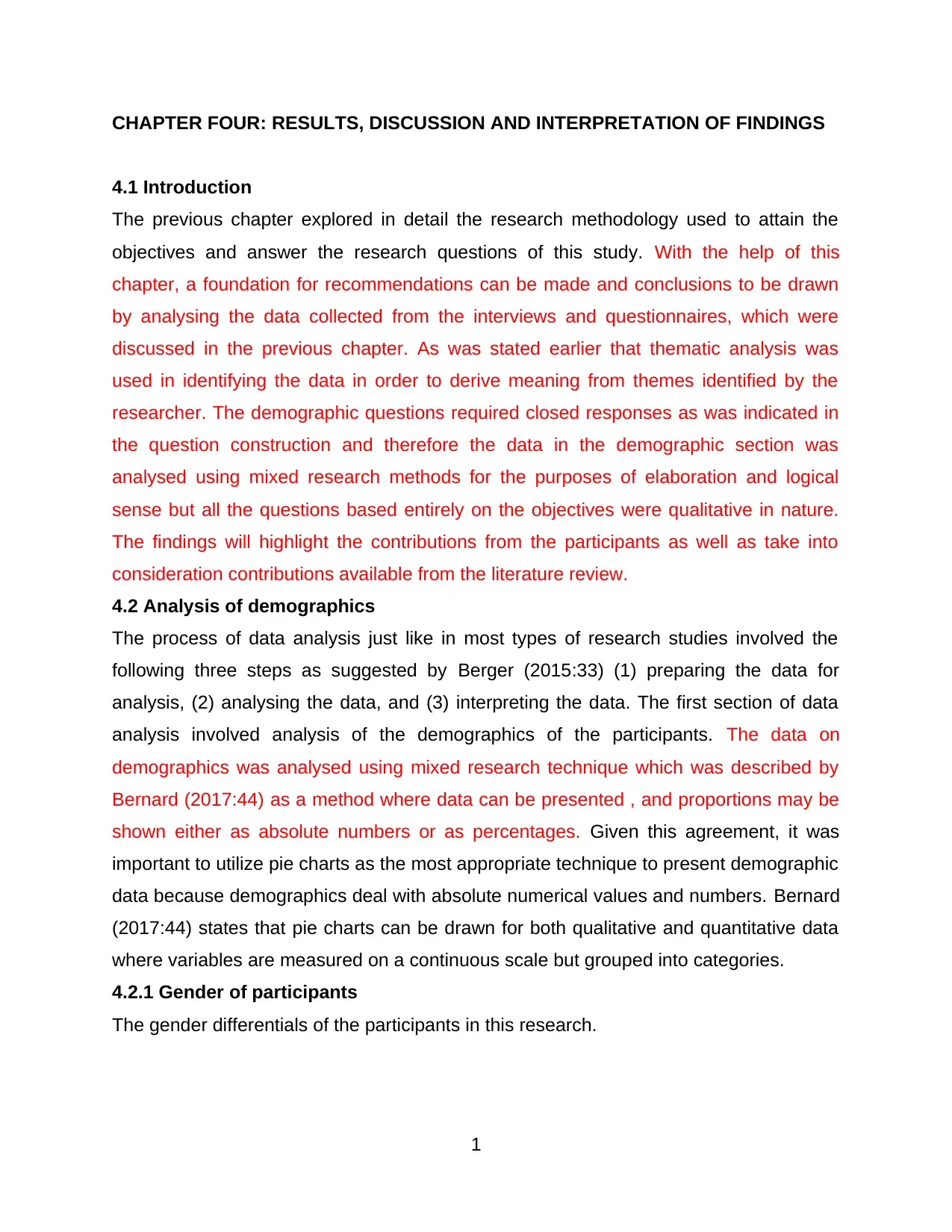
CHAPTER FOUR: RESULTS, DISCUSSION AND INTERPRETATION OF FINDINGS
4.1 Introduction
The previous chapter explored in detail the research methodology used to attain the
objectives and answer the research questions of this study. With the help of this
chapter, a foundation for recommendations can be made and conclusions to be drawn
by analysing the data collected from the interviews and questionnaires, which were
discussed in the previous chapter. As was stated earlier that thematic analysis was
used in identifying the data in order to derive meaning from themes identified by the
researcher. The demographic questions required closed responses as was indicated in
the question construction and therefore the data in the demographic section was
analysed using mixed research methods for the purposes of elaboration and logical
sense but all the questions based entirely on the objectives were qualitative in nature.
The findings will highlight the contributions from the participants as well as take into
consideration contributions available from the literature review.
4.2 Analysis of demographics
The process of data analysis just like in most types of research studies involved the
following three steps as suggested by Berger (2015:33) (1) preparing the data for
analysis, (2) analysing the data, and (3) interpreting the data. The first section of data
analysis involved analysis of the demographics of the participants. The data on
demographics was analysed using mixed research technique which was described by
Bernard (2017:44) as a method where data can be presented , and proportions may be
shown either as absolute numbers or as percentages. Given this agreement, it was
important to utilize pie charts as the most appropriate technique to present demographic
data because demographics deal with absolute numerical values and numbers. Bernard
(2017:44) states that pie charts can be drawn for both qualitative and quantitative data
where variables are measured on a continuous scale but grouped into categories.
4.2.1 Gender of participants
The gender differentials of the participants in this research.
1
4.1 Introduction
The previous chapter explored in detail the research methodology used to attain the
objectives and answer the research questions of this study. With the help of this
chapter, a foundation for recommendations can be made and conclusions to be drawn
by analysing the data collected from the interviews and questionnaires, which were
discussed in the previous chapter. As was stated earlier that thematic analysis was
used in identifying the data in order to derive meaning from themes identified by the
researcher. The demographic questions required closed responses as was indicated in
the question construction and therefore the data in the demographic section was
analysed using mixed research methods for the purposes of elaboration and logical
sense but all the questions based entirely on the objectives were qualitative in nature.
The findings will highlight the contributions from the participants as well as take into
consideration contributions available from the literature review.
4.2 Analysis of demographics
The process of data analysis just like in most types of research studies involved the
following three steps as suggested by Berger (2015:33) (1) preparing the data for
analysis, (2) analysing the data, and (3) interpreting the data. The first section of data
analysis involved analysis of the demographics of the participants. The data on
demographics was analysed using mixed research technique which was described by
Bernard (2017:44) as a method where data can be presented , and proportions may be
shown either as absolute numbers or as percentages. Given this agreement, it was
important to utilize pie charts as the most appropriate technique to present demographic
data because demographics deal with absolute numerical values and numbers. Bernard
(2017:44) states that pie charts can be drawn for both qualitative and quantitative data
where variables are measured on a continuous scale but grouped into categories.
4.2.1 Gender of participants
The gender differentials of the participants in this research.
1
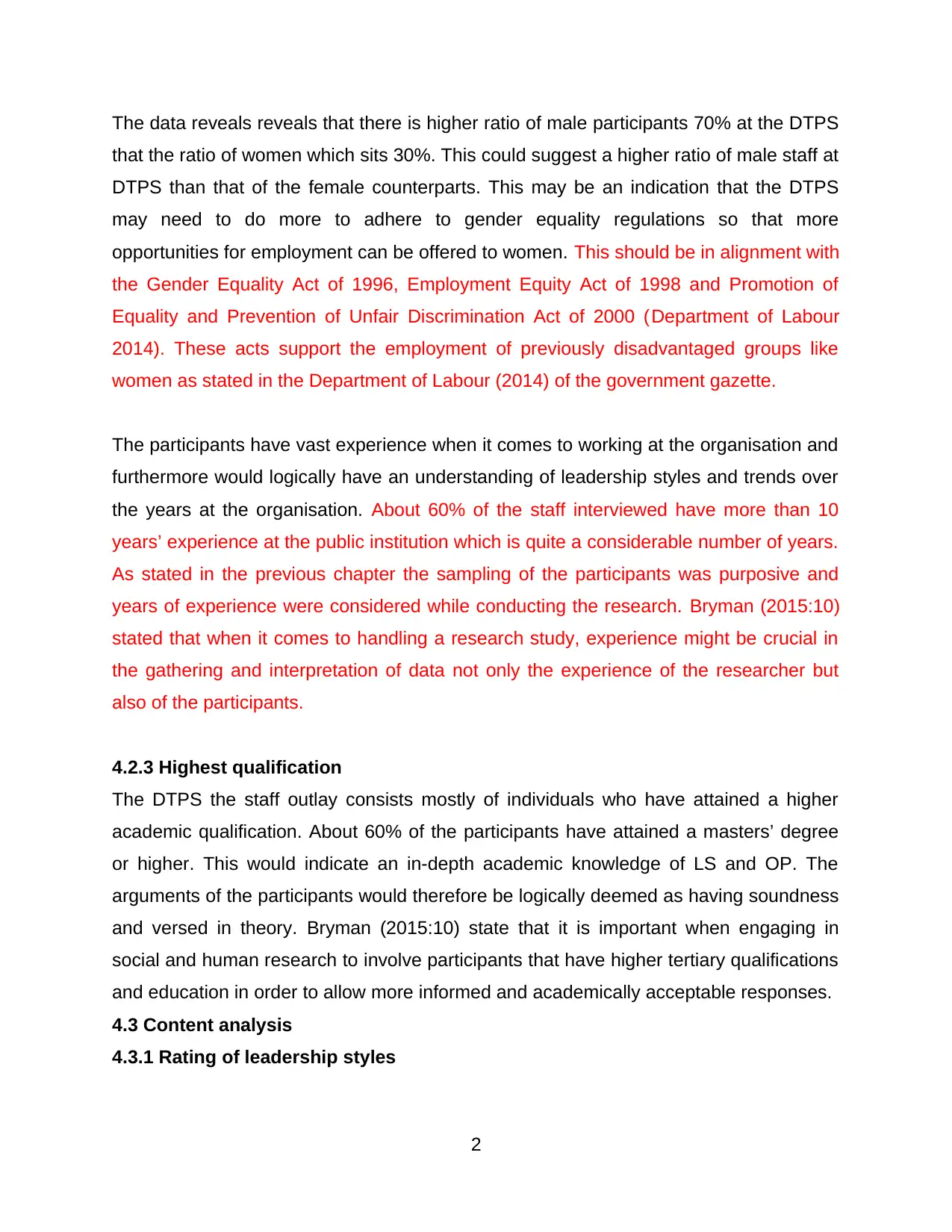
The data reveals reveals that there is higher ratio of male participants 70% at the DTPS
that the ratio of women which sits 30%. This could suggest a higher ratio of male staff at
DTPS than that of the female counterparts. This may be an indication that the DTPS
may need to do more to adhere to gender equality regulations so that more
opportunities for employment can be offered to women. This should be in alignment with
the Gender Equality Act of 1996, Employment Equity Act of 1998 and Promotion of
Equality and Prevention of Unfair Discrimination Act of 2000 (Department of Labour
2014). These acts support the employment of previously disadvantaged groups like
women as stated in the Department of Labour (2014) of the government gazette.
The participants have vast experience when it comes to working at the organisation and
furthermore would logically have an understanding of leadership styles and trends over
the years at the organisation. About 60% of the staff interviewed have more than 10
years’ experience at the public institution which is quite a considerable number of years.
As stated in the previous chapter the sampling of the participants was purposive and
years of experience were considered while conducting the research. Bryman (2015:10)
stated that when it comes to handling a research study, experience might be crucial in
the gathering and interpretation of data not only the experience of the researcher but
also of the participants.
4.2.3 Highest qualification
The DTPS the staff outlay consists mostly of individuals who have attained a higher
academic qualification. About 60% of the participants have attained a masters’ degree
or higher. This would indicate an in-depth academic knowledge of LS and OP. The
arguments of the participants would therefore be logically deemed as having soundness
and versed in theory. Bryman (2015:10) state that it is important when engaging in
social and human research to involve participants that have higher tertiary qualifications
and education in order to allow more informed and academically acceptable responses.
4.3 Content analysis
4.3.1 Rating of leadership styles
2
that the ratio of women which sits 30%. This could suggest a higher ratio of male staff at
DTPS than that of the female counterparts. This may be an indication that the DTPS
may need to do more to adhere to gender equality regulations so that more
opportunities for employment can be offered to women. This should be in alignment with
the Gender Equality Act of 1996, Employment Equity Act of 1998 and Promotion of
Equality and Prevention of Unfair Discrimination Act of 2000 (Department of Labour
2014). These acts support the employment of previously disadvantaged groups like
women as stated in the Department of Labour (2014) of the government gazette.
The participants have vast experience when it comes to working at the organisation and
furthermore would logically have an understanding of leadership styles and trends over
the years at the organisation. About 60% of the staff interviewed have more than 10
years’ experience at the public institution which is quite a considerable number of years.
As stated in the previous chapter the sampling of the participants was purposive and
years of experience were considered while conducting the research. Bryman (2015:10)
stated that when it comes to handling a research study, experience might be crucial in
the gathering and interpretation of data not only the experience of the researcher but
also of the participants.
4.2.3 Highest qualification
The DTPS the staff outlay consists mostly of individuals who have attained a higher
academic qualification. About 60% of the participants have attained a masters’ degree
or higher. This would indicate an in-depth academic knowledge of LS and OP. The
arguments of the participants would therefore be logically deemed as having soundness
and versed in theory. Bryman (2015:10) state that it is important when engaging in
social and human research to involve participants that have higher tertiary qualifications
and education in order to allow more informed and academically acceptable responses.
4.3 Content analysis
4.3.1 Rating of leadership styles
2
⊘ This is a preview!⊘
Do you want full access?
Subscribe today to unlock all pages.

Trusted by 1+ million students worldwide
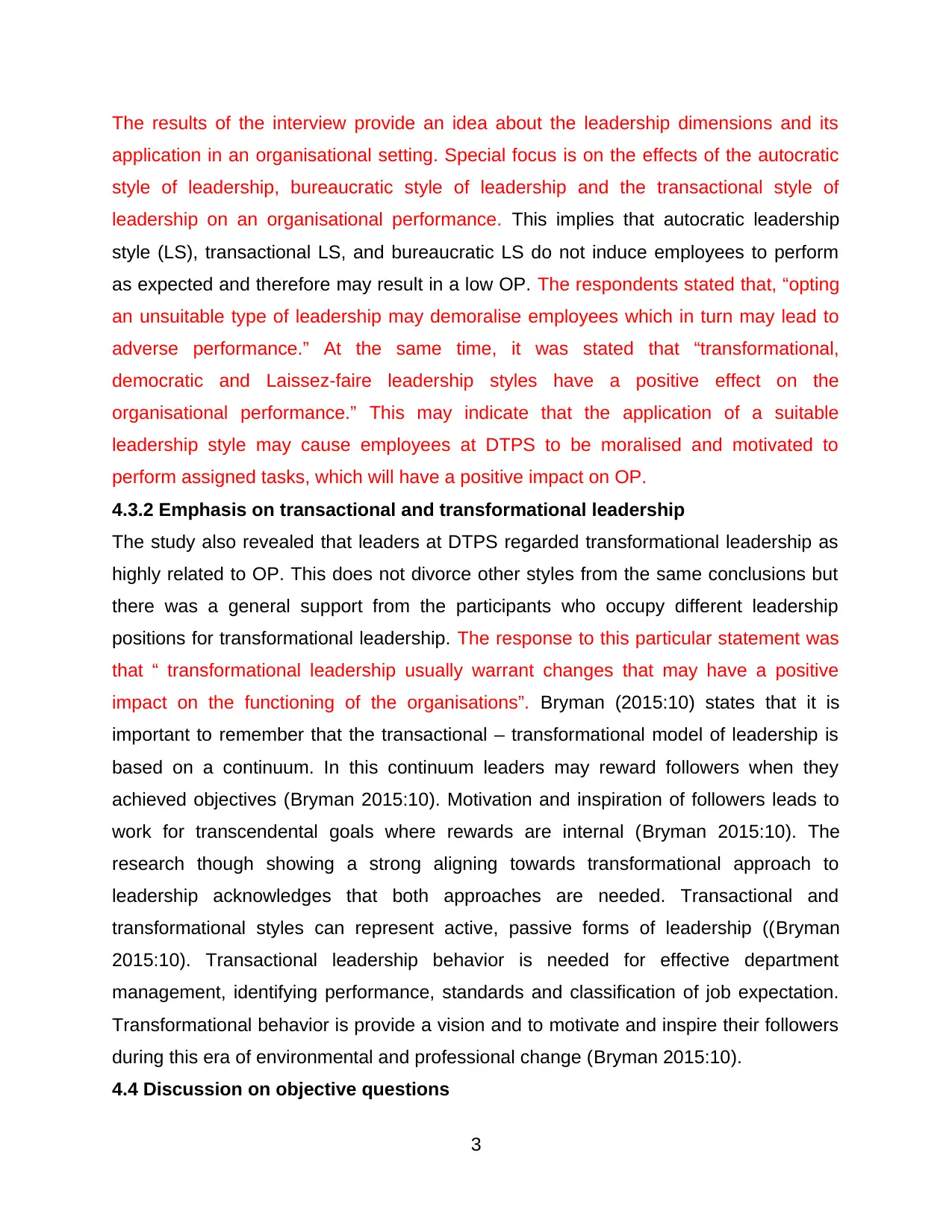
The results of the interview provide an idea about the leadership dimensions and its
application in an organisational setting. Special focus is on the effects of the autocratic
style of leadership, bureaucratic style of leadership and the transactional style of
leadership on an organisational performance. This implies that autocratic leadership
style (LS), transactional LS, and bureaucratic LS do not induce employees to perform
as expected and therefore may result in a low OP. The respondents stated that, “opting
an unsuitable type of leadership may demoralise employees which in turn may lead to
adverse performance.” At the same time, it was stated that “transformational,
democratic and Laissez-faire leadership styles have a positive effect on the
organisational performance.” This may indicate that the application of a suitable
leadership style may cause employees at DTPS to be moralised and motivated to
perform assigned tasks, which will have a positive impact on OP.
4.3.2 Emphasis on transactional and transformational leadership
The study also revealed that leaders at DTPS regarded transformational leadership as
highly related to OP. This does not divorce other styles from the same conclusions but
there was a general support from the participants who occupy different leadership
positions for transformational leadership. The response to this particular statement was
that “ transformational leadership usually warrant changes that may have a positive
impact on the functioning of the organisations”. Bryman (2015:10) states that it is
important to remember that the transactional – transformational model of leadership is
based on a continuum. In this continuum leaders may reward followers when they
achieved objectives (Bryman 2015:10). Motivation and inspiration of followers leads to
work for transcendental goals where rewards are internal (Bryman 2015:10). The
research though showing a strong aligning towards transformational approach to
leadership acknowledges that both approaches are needed. Transactional and
transformational styles can represent active, passive forms of leadership ((Bryman
2015:10). Transactional leadership behavior is needed for effective department
management, identifying performance, standards and classification of job expectation.
Transformational behavior is provide a vision and to motivate and inspire their followers
during this era of environmental and professional change (Bryman 2015:10).
4.4 Discussion on objective questions
3
application in an organisational setting. Special focus is on the effects of the autocratic
style of leadership, bureaucratic style of leadership and the transactional style of
leadership on an organisational performance. This implies that autocratic leadership
style (LS), transactional LS, and bureaucratic LS do not induce employees to perform
as expected and therefore may result in a low OP. The respondents stated that, “opting
an unsuitable type of leadership may demoralise employees which in turn may lead to
adverse performance.” At the same time, it was stated that “transformational,
democratic and Laissez-faire leadership styles have a positive effect on the
organisational performance.” This may indicate that the application of a suitable
leadership style may cause employees at DTPS to be moralised and motivated to
perform assigned tasks, which will have a positive impact on OP.
4.3.2 Emphasis on transactional and transformational leadership
The study also revealed that leaders at DTPS regarded transformational leadership as
highly related to OP. This does not divorce other styles from the same conclusions but
there was a general support from the participants who occupy different leadership
positions for transformational leadership. The response to this particular statement was
that “ transformational leadership usually warrant changes that may have a positive
impact on the functioning of the organisations”. Bryman (2015:10) states that it is
important to remember that the transactional – transformational model of leadership is
based on a continuum. In this continuum leaders may reward followers when they
achieved objectives (Bryman 2015:10). Motivation and inspiration of followers leads to
work for transcendental goals where rewards are internal (Bryman 2015:10). The
research though showing a strong aligning towards transformational approach to
leadership acknowledges that both approaches are needed. Transactional and
transformational styles can represent active, passive forms of leadership ((Bryman
2015:10). Transactional leadership behavior is needed for effective department
management, identifying performance, standards and classification of job expectation.
Transformational behavior is provide a vision and to motivate and inspire their followers
during this era of environmental and professional change (Bryman 2015:10).
4.4 Discussion on objective questions
3
Paraphrase This Document
Need a fresh take? Get an instant paraphrase of this document with our AI Paraphraser
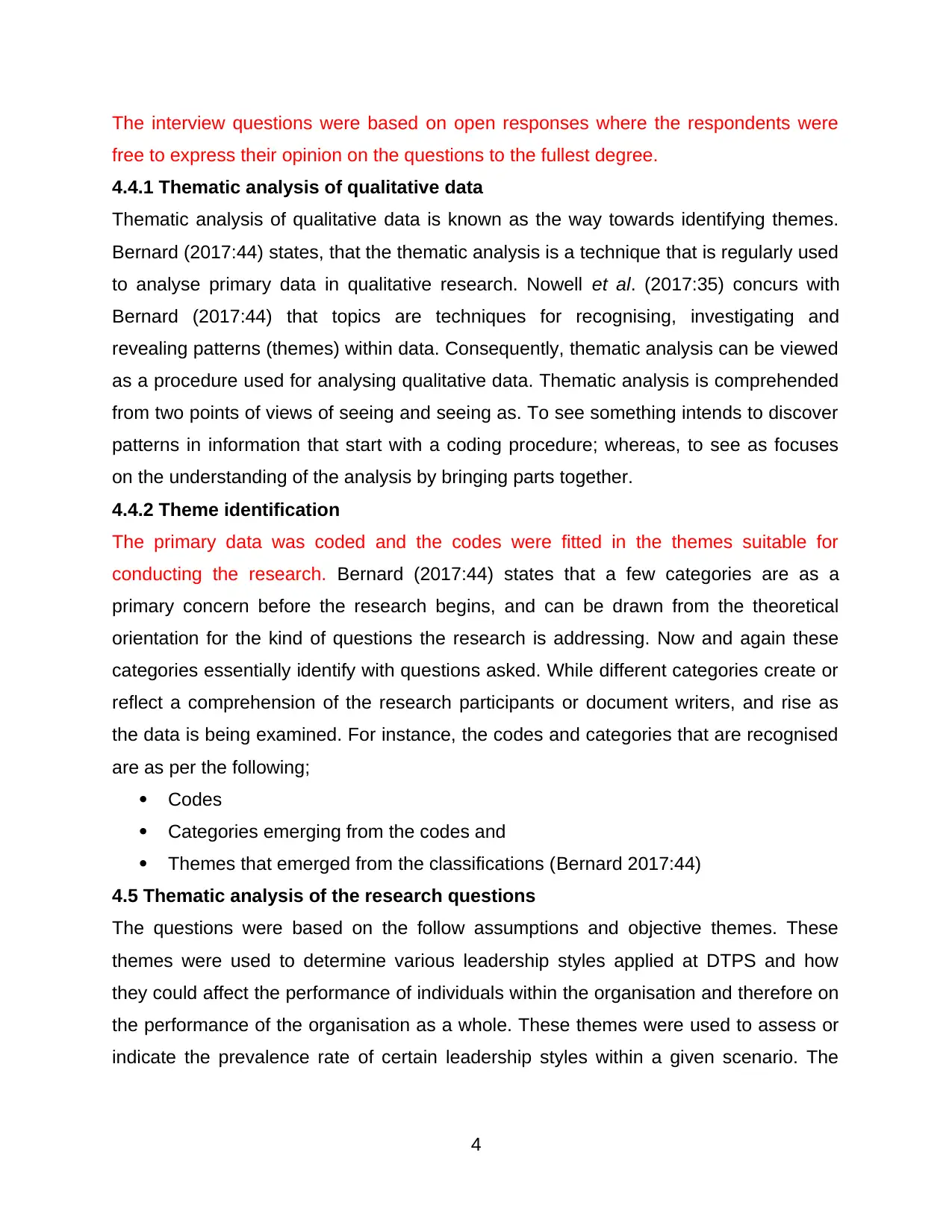
The interview questions were based on open responses where the respondents were
free to express their opinion on the questions to the fullest degree.
4.4.1 Thematic analysis of qualitative data
Thematic analysis of qualitative data is known as the way towards identifying themes.
Bernard (2017:44) states, that the thematic analysis is a technique that is regularly used
to analyse primary data in qualitative research. Nowell et al. (2017:35) concurs with
Bernard (2017:44) that topics are techniques for recognising, investigating and
revealing patterns (themes) within data. Consequently, thematic analysis can be viewed
as a procedure used for analysing qualitative data. Thematic analysis is comprehended
from two points of views of seeing and seeing as. To see something intends to discover
patterns in information that start with a coding procedure; whereas, to see as focuses
on the understanding of the analysis by bringing parts together.
4.4.2 Theme identification
The primary data was coded and the codes were fitted in the themes suitable for
conducting the research. Bernard (2017:44) states that a few categories are as a
primary concern before the research begins, and can be drawn from the theoretical
orientation for the kind of questions the research is addressing. Now and again these
categories essentially identify with questions asked. While different categories create or
reflect a comprehension of the research participants or document writers, and rise as
the data is being examined. For instance, the codes and categories that are recognised
are as per the following;
Codes
Categories emerging from the codes and
Themes that emerged from the classifications (Bernard 2017:44)
4.5 Thematic analysis of the research questions
The questions were based on the follow assumptions and objective themes. These
themes were used to determine various leadership styles applied at DTPS and how
they could affect the performance of individuals within the organisation and therefore on
the performance of the organisation as a whole. These themes were used to assess or
indicate the prevalence rate of certain leadership styles within a given scenario. The
4
free to express their opinion on the questions to the fullest degree.
4.4.1 Thematic analysis of qualitative data
Thematic analysis of qualitative data is known as the way towards identifying themes.
Bernard (2017:44) states, that the thematic analysis is a technique that is regularly used
to analyse primary data in qualitative research. Nowell et al. (2017:35) concurs with
Bernard (2017:44) that topics are techniques for recognising, investigating and
revealing patterns (themes) within data. Consequently, thematic analysis can be viewed
as a procedure used for analysing qualitative data. Thematic analysis is comprehended
from two points of views of seeing and seeing as. To see something intends to discover
patterns in information that start with a coding procedure; whereas, to see as focuses
on the understanding of the analysis by bringing parts together.
4.4.2 Theme identification
The primary data was coded and the codes were fitted in the themes suitable for
conducting the research. Bernard (2017:44) states that a few categories are as a
primary concern before the research begins, and can be drawn from the theoretical
orientation for the kind of questions the research is addressing. Now and again these
categories essentially identify with questions asked. While different categories create or
reflect a comprehension of the research participants or document writers, and rise as
the data is being examined. For instance, the codes and categories that are recognised
are as per the following;
Codes
Categories emerging from the codes and
Themes that emerged from the classifications (Bernard 2017:44)
4.5 Thematic analysis of the research questions
The questions were based on the follow assumptions and objective themes. These
themes were used to determine various leadership styles applied at DTPS and how
they could affect the performance of individuals within the organisation and therefore on
the performance of the organisation as a whole. These themes were used to assess or
indicate the prevalence rate of certain leadership styles within a given scenario. The
4
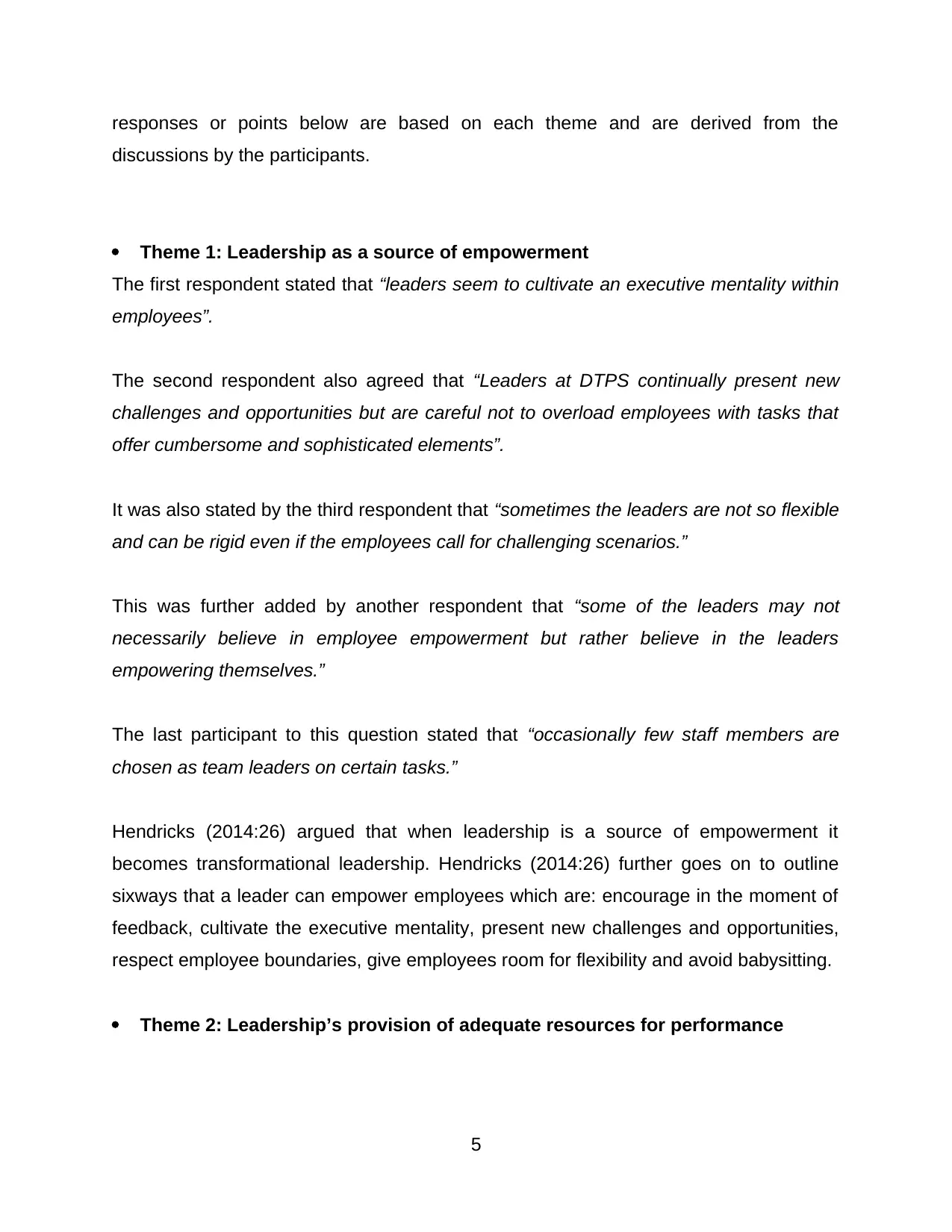
responses or points below are based on each theme and are derived from the
discussions by the participants.
Theme 1: Leadership as a source of empowerment
The first respondent stated that “leaders seem to cultivate an executive mentality within
employees”.
The second respondent also agreed that “Leaders at DTPS continually present new
challenges and opportunities but are careful not to overload employees with tasks that
offer cumbersome and sophisticated elements”.
It was also stated by the third respondent that “sometimes the leaders are not so flexible
and can be rigid even if the employees call for challenging scenarios.”
This was further added by another respondent that “some of the leaders may not
necessarily believe in employee empowerment but rather believe in the leaders
empowering themselves.”
The last participant to this question stated that “occasionally few staff members are
chosen as team leaders on certain tasks.”
Hendricks (2014:26) argued that when leadership is a source of empowerment it
becomes transformational leadership. Hendricks (2014:26) further goes on to outline
sixways that a leader can empower employees which are: encourage in the moment of
feedback, cultivate the executive mentality, present new challenges and opportunities,
respect employee boundaries, give employees room for flexibility and avoid babysitting.
Theme 2: Leadership’s provision of adequate resources for performance
5
discussions by the participants.
Theme 1: Leadership as a source of empowerment
The first respondent stated that “leaders seem to cultivate an executive mentality within
employees”.
The second respondent also agreed that “Leaders at DTPS continually present new
challenges and opportunities but are careful not to overload employees with tasks that
offer cumbersome and sophisticated elements”.
It was also stated by the third respondent that “sometimes the leaders are not so flexible
and can be rigid even if the employees call for challenging scenarios.”
This was further added by another respondent that “some of the leaders may not
necessarily believe in employee empowerment but rather believe in the leaders
empowering themselves.”
The last participant to this question stated that “occasionally few staff members are
chosen as team leaders on certain tasks.”
Hendricks (2014:26) argued that when leadership is a source of empowerment it
becomes transformational leadership. Hendricks (2014:26) further goes on to outline
sixways that a leader can empower employees which are: encourage in the moment of
feedback, cultivate the executive mentality, present new challenges and opportunities,
respect employee boundaries, give employees room for flexibility and avoid babysitting.
Theme 2: Leadership’s provision of adequate resources for performance
5
⊘ This is a preview!⊘
Do you want full access?
Subscribe today to unlock all pages.

Trusted by 1+ million students worldwide
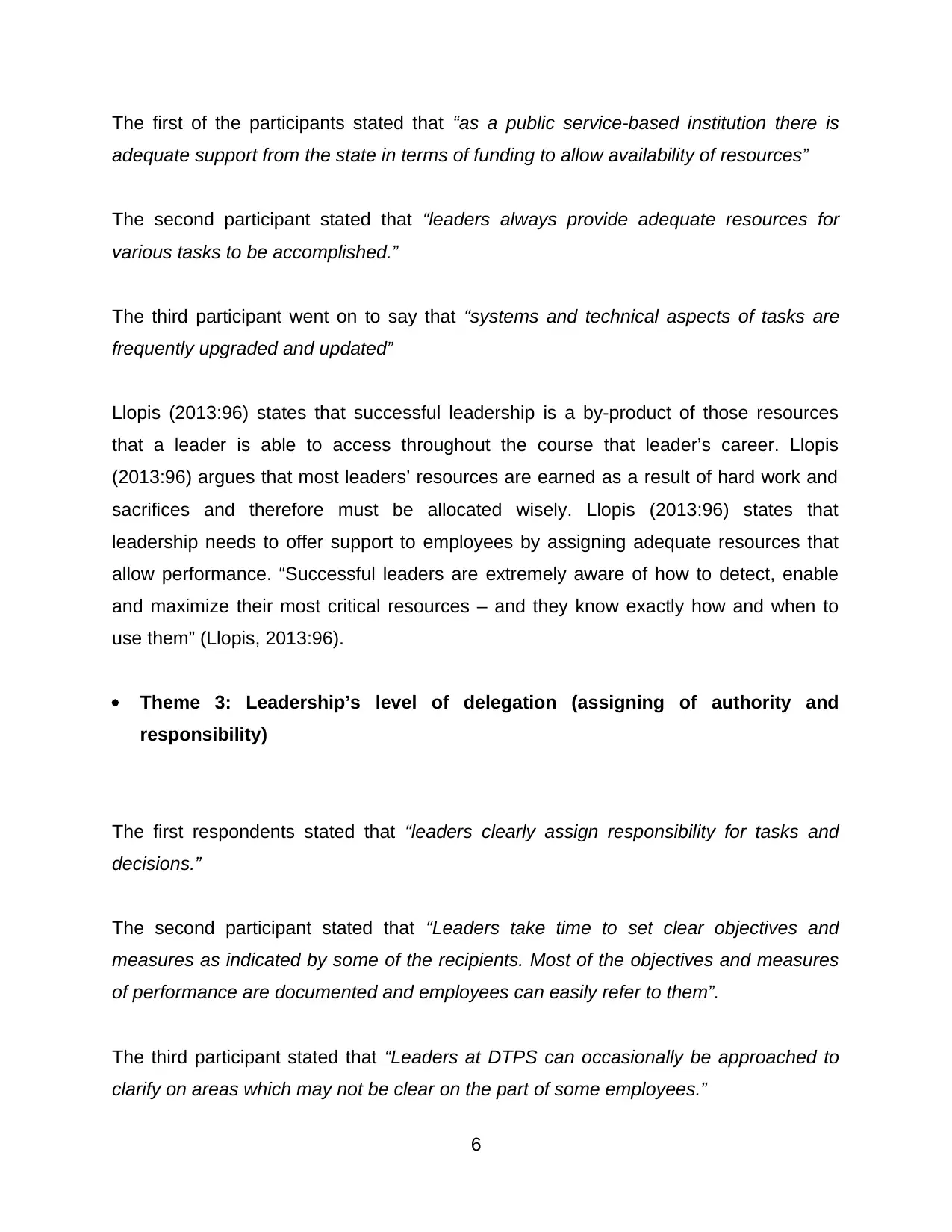
The first of the participants stated that “as a public service-based institution there is
adequate support from the state in terms of funding to allow availability of resources”
The second participant stated that “leaders always provide adequate resources for
various tasks to be accomplished.”
The third participant went on to say that “systems and technical aspects of tasks are
frequently upgraded and updated”
Llopis (2013:96) states that successful leadership is a by-product of those resources
that a leader is able to access throughout the course that leader’s career. Llopis
(2013:96) argues that most leaders’ resources are earned as a result of hard work and
sacrifices and therefore must be allocated wisely. Llopis (2013:96) states that
leadership needs to offer support to employees by assigning adequate resources that
allow performance. “Successful leaders are extremely aware of how to detect, enable
and maximize their most critical resources – and they know exactly how and when to
use them” (Llopis, 2013:96).
Theme 3: Leadership’s level of delegation (assigning of authority and
responsibility)
The first respondents stated that “leaders clearly assign responsibility for tasks and
decisions.”
The second participant stated that “Leaders take time to set clear objectives and
measures as indicated by some of the recipients. Most of the objectives and measures
of performance are documented and employees can easily refer to them”.
The third participant stated that “Leaders at DTPS can occasionally be approached to
clarify on areas which may not be clear on the part of some employees.”
6
adequate support from the state in terms of funding to allow availability of resources”
The second participant stated that “leaders always provide adequate resources for
various tasks to be accomplished.”
The third participant went on to say that “systems and technical aspects of tasks are
frequently upgraded and updated”
Llopis (2013:96) states that successful leadership is a by-product of those resources
that a leader is able to access throughout the course that leader’s career. Llopis
(2013:96) argues that most leaders’ resources are earned as a result of hard work and
sacrifices and therefore must be allocated wisely. Llopis (2013:96) states that
leadership needs to offer support to employees by assigning adequate resources that
allow performance. “Successful leaders are extremely aware of how to detect, enable
and maximize their most critical resources – and they know exactly how and when to
use them” (Llopis, 2013:96).
Theme 3: Leadership’s level of delegation (assigning of authority and
responsibility)
The first respondents stated that “leaders clearly assign responsibility for tasks and
decisions.”
The second participant stated that “Leaders take time to set clear objectives and
measures as indicated by some of the recipients. Most of the objectives and measures
of performance are documented and employees can easily refer to them”.
The third participant stated that “Leaders at DTPS can occasionally be approached to
clarify on areas which may not be clear on the part of some employees.”
6
Paraphrase This Document
Need a fresh take? Get an instant paraphrase of this document with our AI Paraphraser

Other participants indicated that “monitoring of process, progress, and results is a
moderate practice at the DTPS. It has actually become a culture.”
Another participant outlined that “Leaders generally design feedback loops into work
practices as indicated by some participants.”
The last participant echoed the same sentiments but stating that “This therefore means
that participants are acquainted with feedback systems and upward communication
channels are made smoother and easier for employees.”
Tracy (2018:22) states that “Learning how to delegate effectively is the key to
leveraging yourself and multiplying your value to your company (as a leader)”.
Delegation allows a leader to move from what they can do personally to what they can
manage. Tracy (2018:22) argues that delegation is one of the most important and
effective management skills because without the ability to delegate effectively, it is
impossible for a leader to advance in management to higher positions of responsibility.
Theme 4: Leadership training and development
The first participant indicated that “The DTPS lays emphasis on education as the
department is under the leadership of an educated leader, the Director-General of
DTPS, and therefore academic upgrade is made a prerequisite at the DTPS as agreed
by all participants.”
Another participant said “Training and development on leadership although it’s there but
it may not be adequate enough as indicated by some of the employees.”
Another participant did indicate that “leadership has emphasis on performance and
often assists in on-the-job training where necessary although this is only occasionally.”
7
moderate practice at the DTPS. It has actually become a culture.”
Another participant outlined that “Leaders generally design feedback loops into work
practices as indicated by some participants.”
The last participant echoed the same sentiments but stating that “This therefore means
that participants are acquainted with feedback systems and upward communication
channels are made smoother and easier for employees.”
Tracy (2018:22) states that “Learning how to delegate effectively is the key to
leveraging yourself and multiplying your value to your company (as a leader)”.
Delegation allows a leader to move from what they can do personally to what they can
manage. Tracy (2018:22) argues that delegation is one of the most important and
effective management skills because without the ability to delegate effectively, it is
impossible for a leader to advance in management to higher positions of responsibility.
Theme 4: Leadership training and development
The first participant indicated that “The DTPS lays emphasis on education as the
department is under the leadership of an educated leader, the Director-General of
DTPS, and therefore academic upgrade is made a prerequisite at the DTPS as agreed
by all participants.”
Another participant said “Training and development on leadership although it’s there but
it may not be adequate enough as indicated by some of the employees.”
Another participant did indicate that “leadership has emphasis on performance and
often assists in on-the-job training where necessary although this is only occasionally.”
7

Another participant said that “The DTPS does not offer in-house skill-based training
courses.”
According to the Tracy (2018:22), “Training presents a prime opportunity to expand the
knowledge base of all employees, but many employers in the current climate find
development opportunities expensive.” Training and development has potential
drawbacks for both the individual and organisations as a whole but it has benefits that
make the cost and time a worthwhile investment. The return on investment from training
and development of employees often reaps huge rewards.
Theme 5: Leadership level of participation in task related problem-solving
“Leadership rarely participates in operational tasks and tactical activities as they are
normally engaged in management matters and conceptual decision making,” outlined
the first participant.
The second participant outlined that “participation is guaranteed from leadership is
certain tasks are behind schedule so participation is normally through intervention is in a
certain sense.”
The third participant was of the opinion that “an overall participation gap exists at DTPS
and frequently staff handles tasks alone.”
Other participants were unanimously of the opinion that leadership need to be made
flexible based on the capability of the team members. It needs to be based on the
situation that arises within the team so that organizational performance can be
improved.
The tenth participant to this question mentioned that “supervision and monitoring is high
at the organisation.”
Theme 6: Leadership level of decentralization of decision making
The first participant stated that “strategic planning has never involved junior staff
members.”
8
courses.”
According to the Tracy (2018:22), “Training presents a prime opportunity to expand the
knowledge base of all employees, but many employers in the current climate find
development opportunities expensive.” Training and development has potential
drawbacks for both the individual and organisations as a whole but it has benefits that
make the cost and time a worthwhile investment. The return on investment from training
and development of employees often reaps huge rewards.
Theme 5: Leadership level of participation in task related problem-solving
“Leadership rarely participates in operational tasks and tactical activities as they are
normally engaged in management matters and conceptual decision making,” outlined
the first participant.
The second participant outlined that “participation is guaranteed from leadership is
certain tasks are behind schedule so participation is normally through intervention is in a
certain sense.”
The third participant was of the opinion that “an overall participation gap exists at DTPS
and frequently staff handles tasks alone.”
Other participants were unanimously of the opinion that leadership need to be made
flexible based on the capability of the team members. It needs to be based on the
situation that arises within the team so that organizational performance can be
improved.
The tenth participant to this question mentioned that “supervision and monitoring is high
at the organisation.”
Theme 6: Leadership level of decentralization of decision making
The first participant stated that “strategic planning has never involved junior staff
members.”
8
⊘ This is a preview!⊘
Do you want full access?
Subscribe today to unlock all pages.

Trusted by 1+ million students worldwide
1 out of 17
Related Documents
Your All-in-One AI-Powered Toolkit for Academic Success.
+13062052269
info@desklib.com
Available 24*7 on WhatsApp / Email
![[object Object]](/_next/static/media/star-bottom.7253800d.svg)
Unlock your academic potential
Copyright © 2020–2025 A2Z Services. All Rights Reserved. Developed and managed by ZUCOL.





